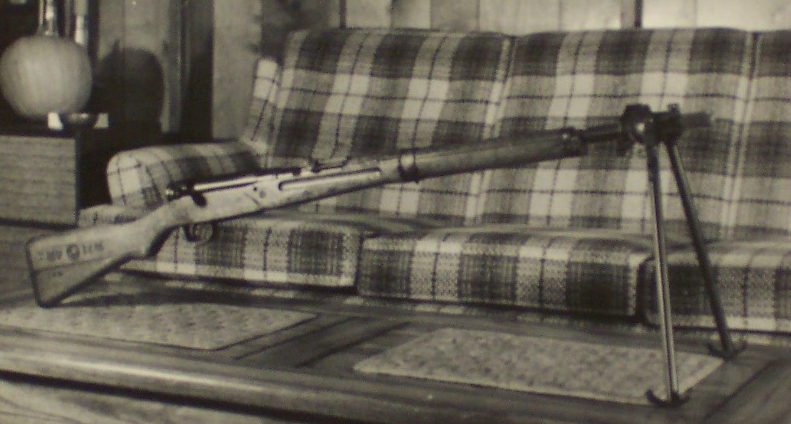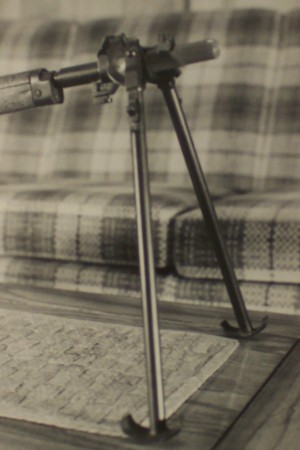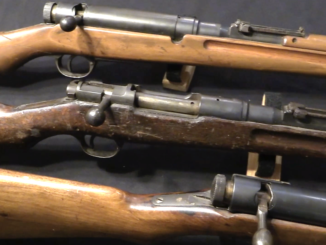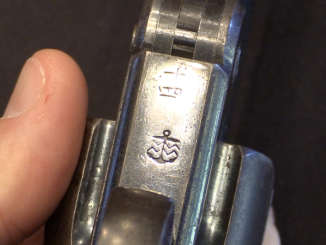I recently had a chance to take a look at a rifle that has been floating around the Japanese collector’s community causing grief since for at least 25 years. It is a Type 99 Arisaka, specifically a first-series Nagoya production gun, serial number 84664. What makes it unusual is that it had a Type 96 or Type 99 Nambu light machine gun bipod attached to the muzzle.
In theory, this is supposed to be an experimental rifle from Nagoya during the period when they were about to stop mounting bayonets on new-production Type 99 rifles. It is supposed to be one of several different test models made to evaluate different bipod/monopod options, which does fit the time period when this rifle was originally made. The rifle’s monopod lug was ground off of its barrel band, and the stock and handguard were cut back several inches to make space to mount the bipod. The bayonet lug on the bipod is correctly positioned, so a standard Type 30 bayonet will still fit and latch securely. The bipod and bayonet lug are numbered to match the rest of the rifle, and the dust cover and stock have been marked with characters suggesting that it is test rifle #22 from Nagoya.
Problem is, the bipod was added by a US collector in the late 70s or early 80s, not by Nagoya Arsenal. It was produced as a practical joke on another collector, and later found its way into circulation, being advertised as a real Japanese prototype. I learned this backstory from a noted collector who was offered the rifle back in the 80s, and spoke to its original creator. Unfortunately, prior to the internet it was difficult to make this sort of thing widely known, and each time someone went to sell it they had already invested in it as if it was legit, and thus wanted to recoup their money or make a nice profit on it.
Here is the rifle back in the 80s (you can tell from the couch), back when my correspondent was offered it:


Having handled the gun, I have to say that I really liked the way it handled. The Nambu bipod is lighter than you might expect, and I think it works pretty well in this application. If I could buy this piece for the price of a well-sporterized Type 99, I would absolutely do so. But as a collector, one has to be careful to view novelties with some skepticism – just because we like something doesn’t mean it is historically legitimate. Caveat emptor, as always.




Back when this was created, Arisakas were considered low-value rifles, mainly esteemed for conversion into low-budget “deer rifles”.
The breakdown sniper rifle in the movie Dirty Harry (1971) was a heavily sporterized Type 99-2 takedown parachutist’s rifle. Back then, they sold for under $100 in mint condition. Today, an unaltered one can go well into four figures at auction.
To play a prank on another collector, the creator of this critter butchered at least one and possibly two fairly rare items, notably the early-production Arisaka. And the “conversion” isn’t even very practical. Among other things, the upward pressure of that bipod when deployed, and even its mass when folded, bearing directly on the barrel will inevitably cause vertical stringing in groups, rather negating any improvement in accuracy the bipod supposedly lends to the gadget.
Like you, Ian, I’d buy it as a shooter if it were available at a reasonable price. Then I’d recoup at least part of the investment by unshipping that bipod and selling it to someone who needed it to restore a Nambu LMG.
cheers
eon
Ian, if you can get it for a decent price, it would be best to take this rifle out of circulation, lest somehow it winds up back on the market and into the hands of some unscrupulous dealer or unsuspecting novice collector. In my 3+ decades of collecting, I have been burned a couple of times and seen it happen to others and, quite frankly, it has taken some fun out of the hobby for me. That rifle may have been created as a joke, but I am sure that someone who paid good money for that thing doesn’t find it all that funny. Hopefully you can get some use out of it.
I think this one is a well-documented enough fake that there’s little worry in that regard.
I agree with Doc on this fabricated item. I understand that this kind of situation might well be behind some ‘rare’ or ‘strange’ trials’ versions of experimental prototypes of fairly common guns out there… Caveat emptor!
Eon, Doc and Ruy are all correct, and I heartily concur. This is an interesting rifle with a colorful history, but that non-original, highly-doctored bipod installation makes some of those colors just a little too garish for comfort, so to speak.
The incredibly strong and now-legendary Arisaka action has long since come to make a mockery of the highly-prejudiced and totally ignorant early wartime and post-war Western assumptions about the supposed shoddiness of the rifle. Those Allied servicemen who had direct exposure to, and contact with, Arisakas were the only ones in that time period who knew better in the face of the propaganda being spouted by their own governments. Amazingly, this same misconception and prejudice can still be found to this very day in some isolated quarters here in the United States. Cherished myths tend to die hard, even in the face of overwhelming evidence to the contrary — such is the human psyche.
I have a sporterized Type 99 that I bought as a shooter. It is one of the absolute gems of my tiny collection. The Arisaka take on Paul Mauser’s baby is easily one of the best. I personally love the design of the safety on them.
I guess no one else is wondering if Ian’s dad is one of the collectors?
Heh – I didn’t even think about that. No, there is no family involvement with this story anywhere.
Even some Aberdeen Prooving Grounds officers thought the Arisaka’s were poor quality compared to other modern (at eh time – late 1940’s).
So they rigged a test. As I recall they anchored a German M98k, Springfield 1903A1 and a Type 99 to a test bed. A bullet was then wedged about 3/4 length into each barrel. A standard issue ball round was then fired from each rifle. The sole rifle still able to fire at the end was the Type 99. The stock had split and the bolt had to be forced open with a rubber mallet.
This was not a sanctioned official test, but was done by the officers on a whim. But it changed the mind of many who saw and read about it.
Was there a spring loaded mono pod for the naval arisaka that was used in Anti aircraft role? This is distinctly different from the bbq tong monopod. It is not integrated into the rifle storage.
No, the only monopod actually used by the Japanese on Arisakas was the basic one on the Type 99.
Can I send you a photo of this thing that was stored with my fathers naval Arisaka accessories? Unless it is part of antique traction or exercise equipment, I cant determine how it works, but it certainly would hold a gun barrel like a door gunner mount. It may have nothing to do with guns.